The concept of the fastest ball in sports is an intriguing subject that spans various disciplines, each with its remarkable achievements and record-breaking moments.
To comprehensively explore this topic, we’ll delve into the historical context, the physics involved, and the human endeavors that have propelled the boundaries of speed in sports.

Exploring the Quest for Speed: An Overview of History
The pursuit of speed has been an enduring aspect of sports, with athletes and engineers alike striving to surpass records and accomplish new feats.
From the early days of cricket, where bowlers like England’s Harold Larwood revolutionized fast bowling during the Bodyline series.
To contemporary baseball pitchers hurling fastballs at astonishing velocities, the quest for the fastest ball has persisted.
Understanding the Physics of Speed
The science behind the fastest balls in sports is grounded in principles of aerodynamics and physics.
Variables such as air resistance, spin, and the elasticity of the ball all significantly influence its speed.
For example, the dimples on a golf ball minimize drag, allowing it to travel faster and farther, while the smooth surface of a cricket ball aids in its high-speed movement through the air.
Also Read: Fastest Car Charger: Rapid Dual-Port Charging On-The-Go.
Notable Moments of Record-Breaking Speed in Sports
Throughout history, numerous sports have witnessed extraordinary speed records.
In cricket, the title for the fastest ball is fiercely contested, with bowlers like Pakistan’s Shoaib Akhtar and Australia’s Brett Lee delivering balls at speeds exceeding 160 km/h.
In tennis, players like Samuel Groth have served balls at over 260 km/h, showcasing the blend of power and precision required at elite levels.
Diverse Speeds Across Various Sports
Speed achievements vary significantly across different sports.
Badminton holds the record for the fastest smash, with Malaysia’s Tan Boon Hoeng striking a shuttlecock at a remarkable 493 km/h during a test of new racket technology.
Conversely, the fastest recorded pitch in baseball by Aroldis Chapman stands at 105.1 mph (169.1 km/h)
Highlighting the distinct challenges and skills inherent in each sport.
The Human Factor: Training and Technique
Attaining such high speeds entails more than just physical strength; it necessitates rigorous training and refined technique.
Athletes dedicate extensive time to perfecting their form and skills to optimize speed and precision.
The mental aspect of delivering a fast ball under competitive pressure is equally crucial.
Looking Ahead: The Future of Speed in Sports
Advancements in technology present opportunities for even greater speeds in sports.
Innovations in equipment, training methodologies, and sports science continuously push the boundaries of human performance.
The future may witness new records and remarkable displays of speed as athletes and engineers collaborate to unlock unprecedented achievements.
Conclusion
The title of the fastest ball in sports signifies a pinnacle of human accomplishment in speed.
It reflects the dedication, expertise, and scientific insight that athletes and their support teams bring to their respective sports.
As new records and breakthroughs emerge, the allure of speed remains undiminished.
Inspiring future generations to aspire to greatness and surpass the limits of what is deemed possible.